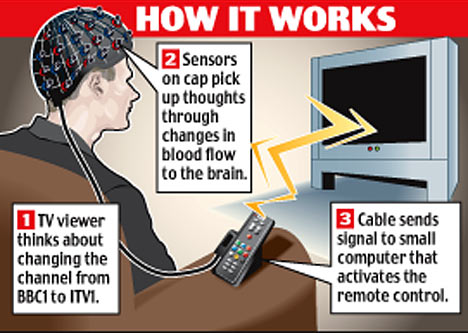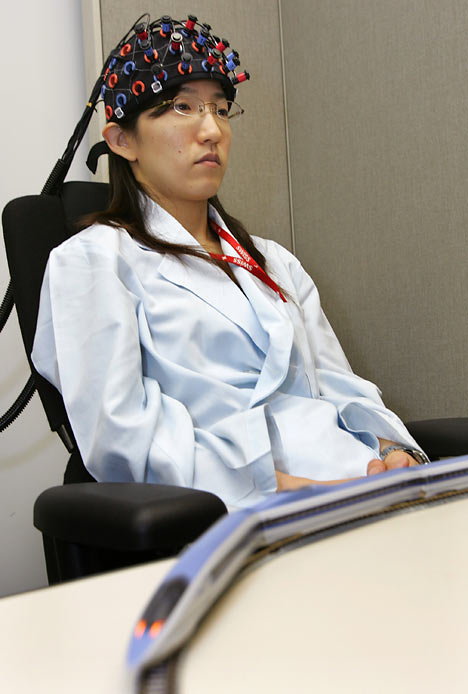FIONA MACRAE for Science & Technology
As any truly dedicated couch potato will tell you, it can be tiring pressing the buttons on the remote control.
But even that exertion might soon be avoided with the arrival of the thought-activated television.
Scientists are refining technology which could allow viewers to change channels or switch the set on and off without lifting a finger.

Staff at the Japanese technology giant Hitachi have already succeeded in harnessing the power of thought to make a model train move and believe it is only a matter of time before the same technology can be applied to the TV remote.
The technique, known as optical topography, reads thoughts by measuring changes in blood flow to key areas of the brain.
The changes - detected by a sensor-covered cap which sends small amounts of infrared light through the brain - are passed to a small computer through optical fibres.
The computer decodes the signal, working out the person's intention. It then triggers the remote control - changing the channel or volume or switching it on or off, as desired. This week, Hitachi demonstrated the "brain-machine interface" in action, when a reporter made a model train move through the power of thought.
Doing simple sums her head activated the frontal cortex - the area of the brain involved in problem solving.
The changes in blood flow to this region were picked up by the sensorcovered cap and sent to a computer which interpreted the result as a command to move the train.
The computer then triggered a motor and the train moved off. When the reporter stopped doing the calculations, the train stopped too.

Underlying Hitachi's brain-machine interface is a technology called optical topography, which maps out changes in blood flow
The technology could one day replace remote controls and computer keyboards and perhaps help the disabled operate electric wheelchairs. It could also be used to help paralysed people communicate - even when they have lost control of all of their muscles.
The power of thought can already be used to control artificial limbs, with brain signals meant for amputated arms caught and redirected to move bionic replacements.
Hitachi is not the only firm hoping to develop the technology, with Honda looking at the possibility of using it in "intelligent" cars.
There are, however, several problems to overcome before the gadgetry is suitable for widespread use.
These include size - although Hitachi has managed to create a cap and computer combination which weighs just 2.2lb - the equivalent of a bag of sugar
As any truly dedicated couch potato will tell you, it can be tiring pressing the buttons on the remote control.
But even that exertion might soon be avoided with the arrival of the thought-activated television.
Scientists are refining technology which could allow viewers to change channels or switch the set on and off without lifting a finger.

Staff at the Japanese technology giant Hitachi have already succeeded in harnessing the power of thought to make a model train move and believe it is only a matter of time before the same technology can be applied to the TV remote.
The technique, known as optical topography, reads thoughts by measuring changes in blood flow to key areas of the brain.
The changes - detected by a sensor-covered cap which sends small amounts of infrared light through the brain - are passed to a small computer through optical fibres.
The computer decodes the signal, working out the person's intention. It then triggers the remote control - changing the channel or volume or switching it on or off, as desired. This week, Hitachi demonstrated the "brain-machine interface" in action, when a reporter made a model train move through the power of thought.
Doing simple sums her head activated the frontal cortex - the area of the brain involved in problem solving.
The changes in blood flow to this region were picked up by the sensorcovered cap and sent to a computer which interpreted the result as a command to move the train.
The computer then triggered a motor and the train moved off. When the reporter stopped doing the calculations, the train stopped too.

Underlying Hitachi's brain-machine interface is a technology called optical topography, which maps out changes in blood flow
The technology could one day replace remote controls and computer keyboards and perhaps help the disabled operate electric wheelchairs. It could also be used to help paralysed people communicate - even when they have lost control of all of their muscles.
The power of thought can already be used to control artificial limbs, with brain signals meant for amputated arms caught and redirected to move bionic replacements.
Hitachi is not the only firm hoping to develop the technology, with Honda looking at the possibility of using it in "intelligent" cars.
There are, however, several problems to overcome before the gadgetry is suitable for widespread use.
These include size - although Hitachi has managed to create a cap and computer combination which weighs just 2.2lb - the equivalent of a bag of sugar

